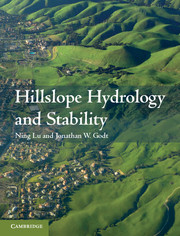Book contents
- Frontmatter
- Contents
- Foreword
- Preface
- List of Symbols
- PART I Introduction and state of the art
- 1 Introduction
- 2 Hillslope geomorphology
- PART II Hillslope hydrology
- Part III Total and effective stress in Hillslopes
- PART IV Hillslope Material properties
- PART V Hillslope stability
- References
- Index
- Plate section
2 - Hillslope geomorphology
from PART I - Introduction and state of the art
Published online by Cambridge University Press: 05 February 2013
- Frontmatter
- Contents
- Foreword
- Preface
- List of Symbols
- PART I Introduction and state of the art
- 1 Introduction
- 2 Hillslope geomorphology
- PART II Hillslope hydrology
- Part III Total and effective stress in Hillslopes
- PART IV Hillslope Material properties
- PART V Hillslope stability
- References
- Index
- Plate section
Summary
Global patterns of precipitation and evaporation
Hydrologic processes describe the form of water movement. Water movement in hillslopes, either in liquid or vapor form, is dynamic. It provides the most common physical mechanism that drives the spatial and temporal variation in stress in hillslopes and thus landslide occurrence. As shown in Figure 2.1, the movement of water in and over a hillslope typically involves several physical processes, namely precipitation, evaporation, transpiration, runoff, infiltration, and saturated groundwater flow. Furthermore, these physical processes are often inter-related and are greatly controlled by a hillslope's physical location, morphology, climatic setting, and the geologic materials of the hillslope.
At a particular location, the rate, amount, and seasonal distribution of precipitation and evaporation are greatly influenced by the global climate. The amount of annual precipitation is largely a function of latitude, the proximity to the moisture source of the ocean or sea, the global atmospheric circulation, and local wind patterns, which are greatly influenced by topography. The dependence of precipitation over land on latitude and proximity to the ocean is illustrated in Figure 2.2. The lightest-shaded land areas indicate the driest regions, which receive an average annual precipitation of less than 25 cm. This zone roughly lies between the latitudes of 17° and 30° N and 17° and 30° S as well as the zone at latitudes higher than 70° in both the southern and northern hemispheres. Examples of locations that lie in these zones of low precipitation are much of northern and southern Africa, southern and western Australia, and much of central Asia.
- Type
- Chapter
- Information
- Hillslope Hydrology and Stability , pp. 27 - 70Publisher: Cambridge University PressPrint publication year: 2013
- 1
- Cited by



